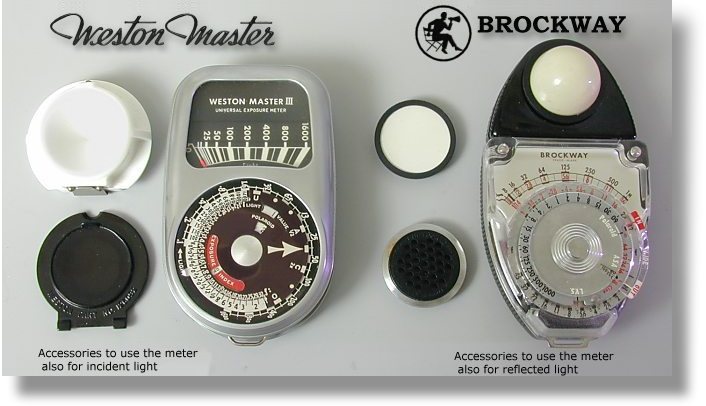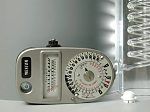
 |
This was an important year in my view. Lightmeters did grew up quickly.
This year both competitors had the EV window and also the Polaroid scales.
It would take some years till Weston took advantage of a needle-lock in their model IV. The respond of the Brockway Director (Now Sekonic) came four years later with their model L-28.(1964) Note also the accessories to convert from reflected to incident light (Weston) and vica versa for the Brockway. Both meters still exist today: Euromaster II (descendant of WestonMaster 1939) and Sekonic L-398-M (descendant of the Director 1948). Remarkable though, both meters changed over the years but the basics are still the same...
|
  Very wellknown are the Weston meters, very nice collector items also, there are about 40 different models.We focus on the Master series and descendants only.
Very wellknown are the Weston meters, very nice collector items also, there are about 40 different models.We focus on the Master series and descendants only.These meters were designed to measure reflected light (luminance) expressed in cd/ft2, however with the invercone attached they were able to measure Incident light. I will give a resume here which are very usefull today: | ||
|
|

  Even more famous in those days, especially in Cinematographer and Filmdirector circles are the Norwood Directors and its descendants like the Brockway and later the Sekonic Studio de Luxe (Still produced today under the name L-398), very nice collector items also, there are many different models, though the basics are still unchanged.
Even more famous in those days, especially in Cinematographer and Filmdirector circles are the Norwood Directors and its descendants like the Brockway and later the Sekonic Studio de Luxe (Still produced today under the name L-398), very nice collector items also, there are many different models, though the basics are still unchanged.
This meter is for measuring illuminance expressed in foot-candles or incident light. Whenever the need arise itcan be used as a reflected light meter also(PhotoGrid). I will give a resume here which are very usefull today: |
  My two Cents...
My two Cents...As a matter of fact it does not matter if the meter is some years of age, the results were right in those days, why should it not work for you and now? Of course there are modern solutions, digital meters with Silicon-blue cell scales to a tenth focus stop. What use? ,if we don't have an electronic shutter! Remember, even the dark-hat method works flawless...for experienced photographers with very old barrel-type lenses. Also a very modern combination with a little hardware (palmtop) and software from BTZS Just enter your variables and you will get the perfect exposure.( If you made a good interpretation that is) Sure it works, but it is still the man behind the machine that makes the difference! For those who want to get rid of Polaroid backs to check the exposure, there is the ultimate machine, a digital camera that works from very old photographic rules, you can now have spot metering, matrix and center-weight. If you like what you see, read the exposure/aperture combination at 100 ISO, recalculate to your film used in the casettes .....expose, et Voilą Now you have a Conventional and a Digital Image, you can even make a Hybride Image. Thanks for reading and have fun... |
|
Author
||| Table of Content
||| History
||| Identification
||| Yesterday's Meters
||| HelioValve
||| Model M-3
||| M series
||| FaQ!! ||| Wanted!! FC TEST ||| SlideShow ||| About slides ||| Condensed Manuals ||| Test Bench ||| Speed reading ||| Quiz ||| Impressum ||| Friends of ND ||| New Cell? Where to buy ||| Ranger 9 ||| E-Mail ||| CD-ROM |



|



